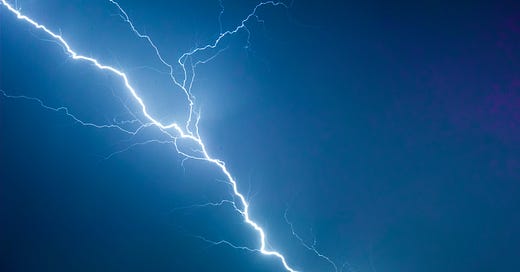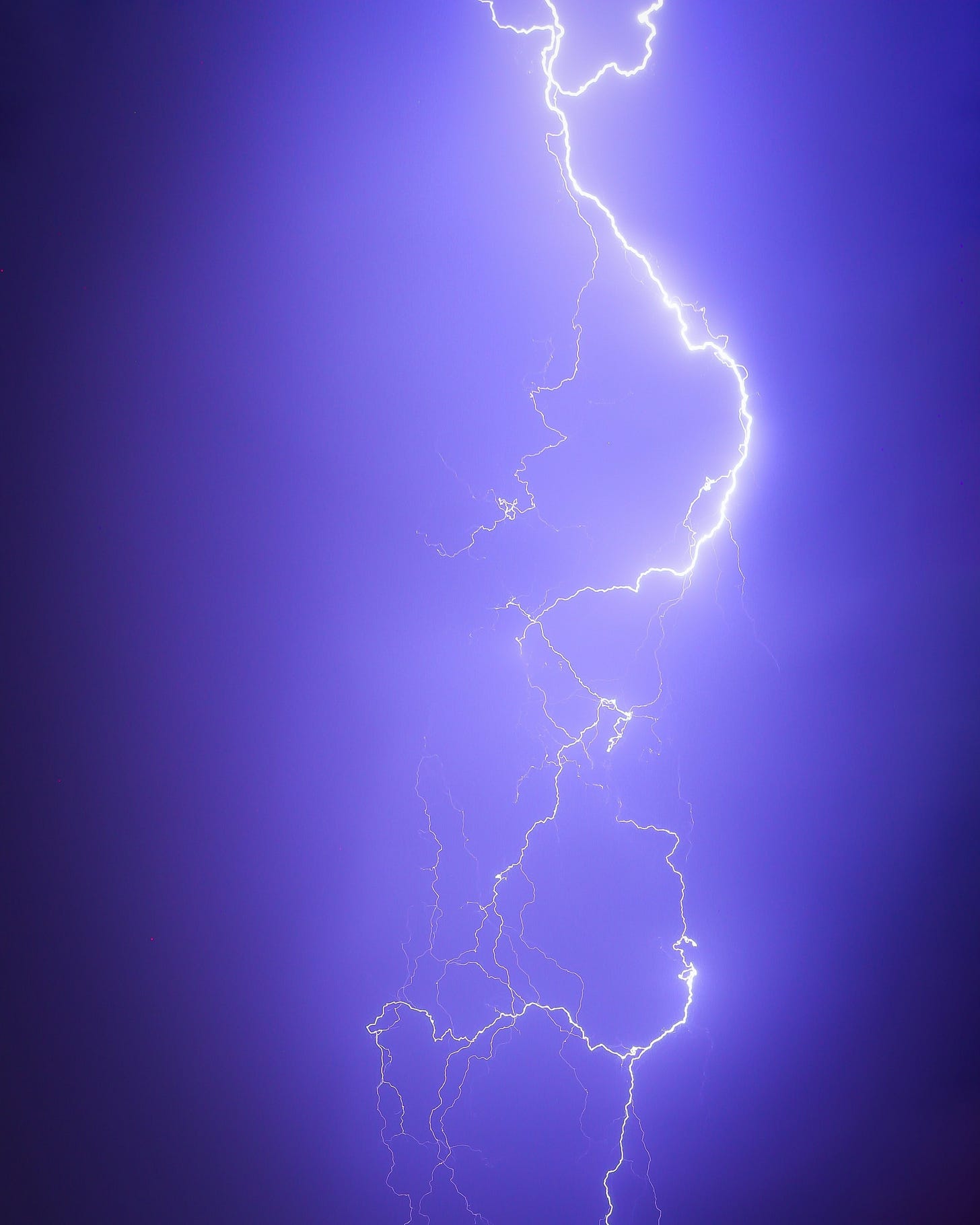Welcome to Thursday Things! If you enjoy this edition, please click the heart icon in the header or at the end of the post to let me know.
If only we could bottle this. Photo by Michał Mancewicz on Unsplash
This week Thursday Things is focused on one topic, because I thought it was super cool and exciting. And it doesn’t even involve lasers, pirates, AI, dog mayors, or flying cars!
Let’s dive in!
There’s something in the air tonight. Photo by Frankie Lopez on Unsplash
It’s electric!
What if I told you there was a way to generate clean, pollution-free energy from thin air?
You’d probably cross the street to get away from me, since that’s what most people do.
Unless you’re Assistant Professor of Electrical and Computer Engineering Jun Yao of the University of Massachusetts Amherst. Then you’d say “Obviously.”
Because you invented it.
Sure, we all complain about the humidity on a sweltering summer day. But it turns out that same humidity could be a source of clean, pollution-free energy, a new study shows.
"Air humidity is a vast, sustainable reservoir of energy that, unlike solar and wind, is continuously available," said the study, which was published recently in the journal Advanced Materials.
“This is very exciting,” said Xiaomeng Liu, a graduate student at the University of Massachusetts-Amherst, and the paper’s lead author. “We are opening up a wide door for harvesting clean electricity from thin air.”
In fact, researchers say, nearly any material can be turned into a device that continuously harvests electricity from humidity in the air.
Wait, did they say continuously harvest electricity from humidity in the air?
Humidity?
As a lifelong resident of the great state of Georgia, let me say we are a humidity superpower. Georgia in the summer is the Saudi Arabia of humidity!1 If you’ve got a thingamawhatsit that can harvest electricity from humid air, then quit wasting time in Massachusetts and get down here. We’ll make billions!
But how does it work?
“The air contains an enormous amount of electricity,” said Jun Yao, assistant professor of electrical and computer engineering at the University of Massachusetts-Amherst and the paper’s senior author. “Think of a cloud, which is nothing more than a mass of water droplets. Each of those droplets contains a charge, and when conditions are right, the cloud can produce a lightning bolt – but we don’t know how to reliably capture electricity from lightning.
"What we’ve done is to create a human-built, small-scale cloud that produces electricity for us predictably and continuously so that we can harvest it.”
Okay, it’s some kind of tiny cloud maker that makes tiny lightning we can bottle. Or something like that. You can get all the science details in Advanced Materials, ‘Generic Air-Gen Effect in Nanoporous Materials for Sustainable Energy Harvesting from Air Humidity’.
But wait, there’s more! Per the UMass press release: “A team of engineers at the University of Massachusetts Amherst has recently shown that nearly any material can be turned into a device that continuously harvests electricity from humidity in the air. The secret lies in being able to pepper the material with nanopores less than 100 nanometers in diameter.”
That is not many nanometers. Here’s more about the implications:
“The idea is simple,” says Yao, “but it’s never been discovered before, and it opens all kinds of possibilities.” The harvester could be designed from literally all kinds of material, offering broad choices for cost-effective and environment-adaptable fabrications. “You could image harvesters made of one kind of material for rainforest environments, and another for more arid regions.”
So we could, in theory, mass produce these energy harvesters cheaply.
“And since humidity is ever-present, the harvester would run 24/7, rain or shine, at night and whether or not the wind blows, which solves one of the major problems of technologies like wind or solar, which only work under certain conditions.
So this Air-gen technology one ups the wind and solar industries by being both sustainable and reliable. Which I doubt they’ll like.
Finally, because air humidity diffuses in three-dimensional space and the thickness of the Air-gen device is only a fraction of the width of a human hair, many thousands of them can be stacked on top of each other, efficiently scaling up the amount of energy without increasing the footprint of the device. Such an Air-gen device would be capable of delivering kilowatt-level power for general electrical utility usage.
I know what you’re thinking — “kilowatt-level power” doesn’t sound like much, right?
Don’t we need megawatts and gigawatts generated by huge dams and power plants and forests of wind turbines and vast desert ecosystems sacrificed to solar farms?
Well, yes and no. Our economy, our entire global civilization, needs a lot of power, including a lot of electricity, to do its thing. And at the dawn of the Electric Age back in the 19th century, right through today, the only way to efficiently supply that electricity was to build centralized power plants that each generate a lot of electricity — and then distribute it from those central places through an extensive network of powerlines. The electric grid.
But that isn’t the only way to supply electricity. Some people already live “off the grid” with their own generators, or solar panels, or what have you. We don’t necessarily need every home and business to be hooked into the same gigantic grid.
What? No, we’re totally not an invasion of giant aliens! Don’t be ridiculous! Photo by Salam Habash on Unsplash
Moreover, if these “Air-gen” devices really can be made relatively cheaply out of almost any material, then “kilowatt-level power” is great. The average American home consuming 900 kWh a month or 30 kWh a day.2
The point being that in the aggregate, yes, we need gigawatts of electricity to keep the lights on and the refrigerators running3 for a city, state, or the whole nation.
But in our family homes, most of us are operating at the kilowatt level. So if we can, hypothetically, install an Air-gen on the roof or in the backyard, or maybe have a local set-up with the neighborhood, that may be all we need.4
Maybe we can all go off the grid.
Which, of course, is why this research will probably never be heard of again. Along with Professor Yao.5
The Air-gen device will disappear into that big warehouse along with the lost Ark and cold fusion.6
“Imagine a future world in which clean electricity is available anywhere you go,” says Yao. “The generic Air-gen effect means that this future world can become a reality.”
Well, yes. I can imagine it. But so can the utility industry, the wind and solar industries and all their subsidies, and everyone else who profits from the energy status quo7 Do they want “sustainable electricity from air" to become a reality?
Probably not.8
But I hope I’m wrong, because we still have a lot of humidity here in Georgia.
Might as well do something useful with it.
Thank you for reading!
Please click the hearts, leave a comment, and use the share feature to send this issue to a friend who might enjoy it. See you next Thursday!
I know Florida, Louisiana, Hawaii, and probably several other states have higher average humidity than Georgia. In fact, it turns out Alaska is the most humid state!
But Georgia has the best most high quality humidity and you can’t prove me wrong.
You better go catch it!
Per the linked USA Today article: "Yao told the Washington Post that roughly 1 billion air-gens, stacked to be roughly the size of a refrigerator, could produce a kilowatt and partly power a home in ideal conditions.” So my little riff here may be overly optimistic. On the other hand, the technology will surely be improved over time.
You can read the Washington Post article here: https://www.washingtonpost.com/science/2023/05/26/harvest-energy-thin-air/
But for now, Yao and his research team are getting pretty good coverage. Here are a few more articles about the Air-gen technology:
They’re all pulling from the same press release, but each article does have a few quotes and details that the others don’t.
Ask Val Kilmer. https://www.imdb.com/title/tt0120053/
Which includes all the people whose sole apparent purpose in life is protesting the status quo by gluing themselves to works of art and blocking traffic. A technology that actually produces clean pollution-free energy would ruin their whole scene.
Yes, I realize I’m both cynical and an optimist. It’s a gift.





